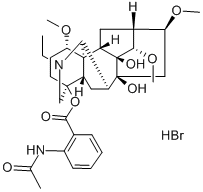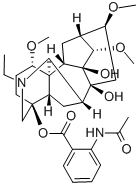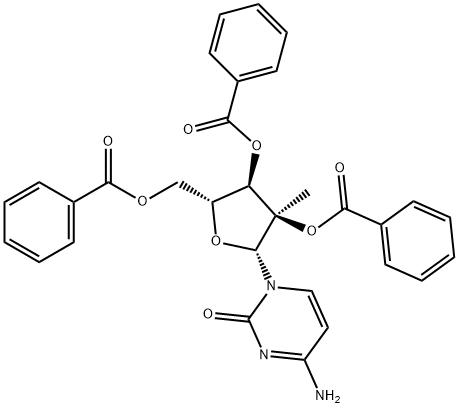1-[(dimethylamino)methyl]-1-methylpropyl benzoate
- CAS NO.:644-26-8
- Empirical Formula: C14H21NO2
- Molecular Weight: 235.32
- MDL number: MFCD00864422
- EINECS: 211-411-1
- SAFETY DATA SHEET (SDS)
- Update Date: 2024-07-18 18:48:51
![1-[(dimethylamino)methyl]-1-methylpropyl benzoate Structural](https://img.chemicalbook.in/CAS/GIF/644-26-8.gif)
What is 1-[(dimethylamino)methyl]-1-methylpropyl benzoate?
Absorption
A lack of detailed information regarding the specificities of amylocaine relate to a lack of information on its pharmacokinetics at the time of its primary use in the early 1900s .
Toxicity
A lack of detailed information regarding the specificities of amylocaine relate to a lack of information on its pharmacokinetics at the time of its primary use in the early 1900s .
Background
Despite the introduction of using cocaine injections for regional anesthesia in 1884, non-addictive substitutes were sought after immediately . Finally, in 1903 the world's first synthetic and non-addictive local anesthetic, amylocaine, was synthesized and patented under the name Forneaucaine by Ernest Fourneau at the Pasteur Institute . Elsewhere in English speaking countries it was referred to as Stovaine, given the meaning of the French word 'fourneau' as 'stove' in English .
Although amylocaine could be administered topically or injected, it was most widely used for spinal anesthesia . Even though it certainly possessed less severe side effects than cocaine , the eventual development and clinical use of newer, more effective, and even safer local anesthetics like lidocaine, bupivicaine, and prilocaine in the 1940s and 1950s superseded and made the use of amylocaine obsolete.
Indications
The most common indication for the usage of amylocaine was spinal anesthesia .
Definition
ChEBI: Stovaine is a benzoate ester.
Pharmacokinetics
Like all other local anesthetics, amylocaine acts as a membrane stabilizing drug that reversibly decreases the rate of depolarization and depolarization of excitable membranes . In this way, the conduction of neuronal signals for certain bodily movements can be blocked . In particular, when administered for spinal anesthesia, the resultant anesthesia can typically extend from the chest to the legs .
Safety Profile
intraperitoneal routes. When heated to decomposition it emits toxicfumes of NOx.
Metabolism
A lack of detailed information regarding the specificities of amylocaine relate to a lack of information on its pharmacokinetics at the time of its primary use in the early 1900s .
Properties of 1-[(dimethylamino)methyl]-1-methylpropyl benzoate
| Boiling point: | 377.72°C (rough estimate) |
| Density | 1.0247 (rough estimate) |
| refractive index | 1.5385 (estimate) |
Safety information for 1-[(dimethylamino)methyl]-1-methylpropyl benzoate
Computed Descriptors for 1-[(dimethylamino)methyl]-1-methylpropyl benzoate
New Products
4-Fluorophenylacetic acid 4-Methylphenylacetic acid N-Boc-D-alaninol N-BOC-D/L-ALANINOL Tert-butyl bis(2-chloroethyl)carbamate 3-Morpholino-1-(4-nitrophenyl)-5,6-dihydropyridin- 2(1H)-one Furan-2,5-Dicarboxylic Acid Tropic acid S-2-CHLORO PROPIONIC ACID ETHYL ISOCYANOACETATE 2-Bromo-1,3-Bis(Dimethylamino)Trimethinium Hexafluorophosphate (6-METHYL-[1,3]DITHIOLO[4,5-b]QUINOXALIN-2-ONE INDAZOLE-3-CARBOXYLIC ACID 4-IODO BENZOIC ACID (2-Hydroxyphenyl)acetonitrile 4-Bromopyrazole 5,6-Dimethoxyindanone 2-(Cyanocyclohexyl)acetic acid 4-methoxy-3,5-dinitropyridine 2-aminopropyl benzoate hydrochloride 1-(4-(aminomethyl)benzyl)urea hydrochloride diethyl 2-(2-((tertbutoxycarbonyl)amino) ethyl)malonate tert-butyl 4- (ureidomethyl)benzylcarbamate Ethyl-2-chloro((4-methoxyphenyl)hydrazono)acetateRelated products of tetrahydrofuran
![1-[(dimethylamino)methyl]-1-methylpropyl benzoate](https://img.chemicalbook.in/CAS/GIF/644-26-8.gif)







You may like
-
 2033-24-1 98%View Details
2033-24-1 98%View Details
2033-24-1 -
 42831-50-5 5-METHYLISOXAZOLE-4-CARBOXYLIC ACID 98%View Details
42831-50-5 5-METHYLISOXAZOLE-4-CARBOXYLIC ACID 98%View Details
42831-50-5 -
 1975-50-4 98%View Details
1975-50-4 98%View Details
1975-50-4 -
 2-HYDROXY BENZYL ALCOHOL 98%View Details
2-HYDROXY BENZYL ALCOHOL 98%View Details
90-01-7 -
 2-Chloro-1,3-Bis(Dimethylamino)Trimethinium Hexafluorophosphate 221615-75-4 98%View Details
2-Chloro-1,3-Bis(Dimethylamino)Trimethinium Hexafluorophosphate 221615-75-4 98%View Details
221615-75-4 -
 61397-56-6 CIS BROMO BENZOATE 98%View Details
61397-56-6 CIS BROMO BENZOATE 98%View Details
61397-56-6 -
 14714-50-2 (2-Hydroxyphenyl)acetonitrile 98+View Details
14714-50-2 (2-Hydroxyphenyl)acetonitrile 98+View Details
14714-50-2 -
 118753-70-1 98+View Details
118753-70-1 98+View Details
118753-70-1